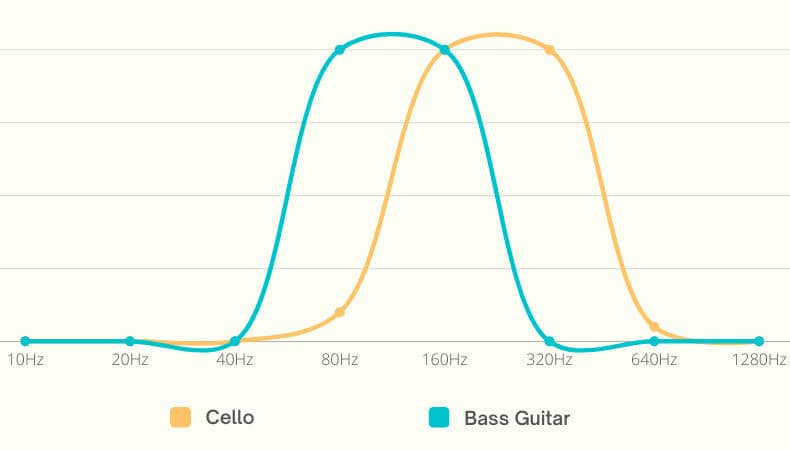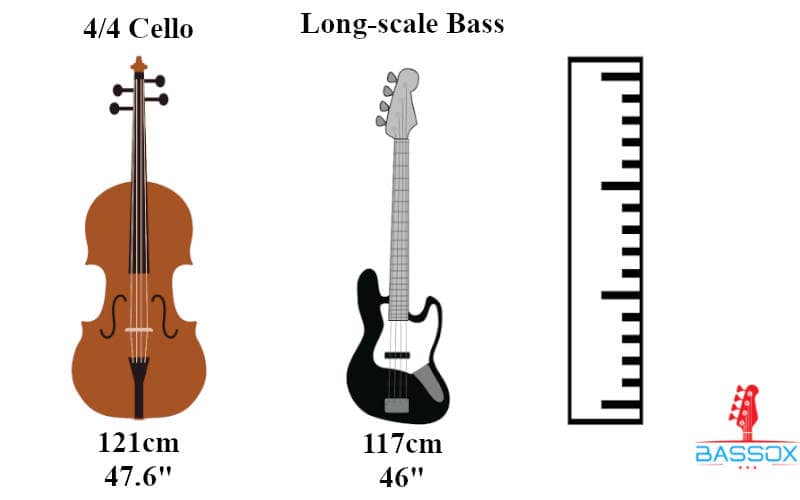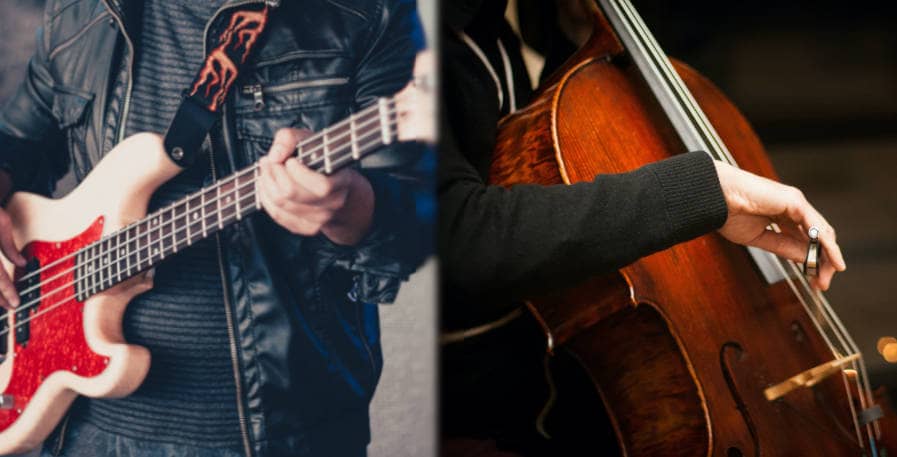On the surface, the bass guitar and cello look and sound vastly different. However, they also tend to fill a similar role in bands and orchestras.
For that reason, I have written this article to showcase every difference between the cello and the bass guitar.
I`ll start off by listing every key difference between the two. Then, I`ll go into detail about the more nuanced differences between the instruments, such as tuning, range, cost, size, and useability.
As a result, you`ll learn exactly how the bass guitar and cello differ, and in what ways they are alike. This will be helpful for anyone who is looking into what instrument they want to play or is looking to expand their overall understanding of music.
Main differences
By just looking at the two instruments, it`s easy to tell that there are some clear differences between the cello and the bass guitar.
However, the instruments also differ in several areas that are not as obvious to the naked eye. Thus, here is a list of the most notable differences between the two:
| 4-String Long-Scale Bass Guitar (20 frets): | 4/4 Full-Size Cello: | |
| Tuning: | E-A-D-G | C-G-D-A |
| Cost of entry-level instrument: | $100-$250 | $400-$2000 |
| Cost of advanced instrument: | $1000+ | $3000+ |
| Weight: | 8-10lb / 3.6kg-4.5kg | 5-7.7lb / 2.2-3.5kg |
| Scale length/ Vibrating string length | 34″ / 86cm | 27.4″ / 62cm |
| Full Length: | ~46″ / ~117cm | 47.6″-51.2″ / 121cm-130cm |
| Strings are played with: | With fingers, a pick, or with the thumb | With a bow, or with the fingers |
| Player position: | Standing or sitting down | Sitting down |
| Main genres: | Pop, Rock | Classical |
| Mainly played in: | Bands | Orchestras, String quartets |
| Role in band or ensemble: | Provide harmonic foundation and low-end grooves | Provide low harmonies and counterpoint melodies |
| Harmonic range: | E1 – D#4 | C2 – E5 |
| Frequency range: | 41.2Hz – 311Hz | 65.4Hz – 659.3Hz |
| Work opportunity and demand: | High | Medium – High |
| As a composing tool: | Mediocre | Good |
| Was invented in: | Originally 1930s, popularized in the 1950s | The 1500s |
| As a solo instrument: | Decent solo instrument. The bass is however most commonly played as an accompanying instrument in bands | Great solo instrument. The cello is played both as a solo instrument and as an accompanying instrument in orchestras and string quartets. |
Tuning
The Cello is tuned C-G-D-A, whereas the standard tuning of a bass guitar is E-A-D-G.
There are two main reasons why the tuning of the instruments makes them feel vastly different.
The first of these is that the strings on a Cello are tuned a perfect 5th apart, while they are tuned a perfect 4th apart on the bass. As a result, the necks of the two instruments require different muscle memory and hand positions.
The other reason is that the Cello is tuned to C, while the bass guitar is tuned to E. Which key an instrument is tuned to has a major impact on how we approach it as musicians. For example, there is a surplus of rock songs in E and A, as these are intuitive keys to write music in on the guitar and bass, which both use E as their standard tuning.
It`s worth mentioning that in some heavier genres of music, bass guitars are commonly tuned down. For example, bassists might tune their basses to Drop D, which results in the strings being tuned D-A-D-G. This creates a perfect fifth interval between the two deepest strings, just like on the cello.
Having some experience playing the bass in a drop tuning will thus give you a good idea of what playing the cello is like. Likewise, a Cello player might find the bass guitar more intuitive to play in a drop tuning.
Range
The Cello is played almost an octave higher than the bass guitar. Thus, while both generally play bass parts, they do so at different frequency ranges.
The Bass guitar and the cello also have a similar amount of total range. A full-size cello has a range of C2 – E5, and a 21-fret bass guitar has a range of E1-E4. Thus, they have exactly the same amount of notes that can be played. They do however differ in what these notes are, and at what pitch they can be played.

This makes sense, as the bass guitar was designed after the double bass. The reason it is called a double bass is that it was designed to double the cello an octave lower in an orchestra.
In bands, the bass guitar`s main role is to provide low-end and the harmonic foundation for chords. Thus, having another instrument play deeper than it would result in the band sounding muddy, and would make the bass guitar redundant.
In an orchestra, the cello is not the deepest instrument. Large symphony orchestras also tend to have 8 -12 cello players. However, the cellos are still usually assigned bass parts. Having the double bassists in the orchestra double the cello parts, in turn, makes for a warm and broad sound that fills the whole frequency spectrum.
The cello is however the deepest instrument in a string quartet. Thus, in a quartet, the cello provides a harmonic and fills in the low-end similar to how a bass guitar does in a band.
Cost
While both instruments have a wide price range, cellos are generally more expensive than bass guitars.
The cost of an entry-level bass guitar of decent quality, an amp, a strap, and a cable will generally come out to about $250-$300.
Bass guitars in this price range vary greatly in quality. Some entry-level instruments have both decent playability and tone. Others are incredibly cumbersome to play and offer very little in terms of tone.
Thus, bear in mind that basses vary greatly in quality between manufacturers. For trusted, yet affordable bass manufacturers, I recommend Epiphone or Squier.
Entry-level cellos can be found as low as $400, but run all the way up to about $2000. The range of cost is so wide, as some beginner cellos are mass-produced, whereas others are hand-crafted. While a mass-produced cello costs as little as 1/3rd of a hand-made one, this is also reflected in the quality of the instrument.
For a beginner, a mass-produced cello can feel like a decent and perfectly playable instrument. However, they are not as well-crafted and well-put-together as handmade instruments. Furthermore, instead of using ebony, which is a sturdy but expensive type of wood, mass-produced cellos tend to use other types of wood that are instead painted black.
Thus, some beginners might opt for a mass-produced cello in order to greatly lower the cost of getting started with the instrument. Others might prefer investing in a high-quality instrument from the get-go.
As for advanced instruments, the sky is the limit for both the cello and the bass.
Intermediate and high-end bass guitars generally cost somewhere in the $1000-$5000 range, and some rare models even exceed 5 digits.
An intermediate cello will generally cost at least $3000, and it’s not uncommon for high-end cellos to sell for 5 digits. Some cellos have been appraised to be worth as much as a million dollars.
Size
Cellos are commonly measured in back length, and the 4/4 cello has a back length of ~30″ (76cm). Bass guitars, on the other hand, are measured in scale length, and the long-scale bass has a scale length of 34″ (86cm).
However, these are measurements that translate poorly when we are looking to compare the two instruments. When comparing the full length of the instruments though, we find that the cello is just barely longer than the bass guitar.

Both instruments are also available in smaller sizes. These instruments can be preferable for young musicians or people on the shorter side. Some also prefer them due to having small hands, or simply out of personal preference.
For cello players, it is paramount to have an instrument that fits their physiology. Thus, there are many common cello sizes that are all commonly played.
| Type of Cello: | Back-length in inches: | Back-length in cm: |
| 7/8 | 27-30″ | 69-76cm |
| 3/4 | 26-27″ | 66-69cm |
| 1/2 | 23-26″ | 58-66cm |
| 1/4 | 20-23″ | 51-58cm |
| 1/8 | 18-20″ | 46-51cm |
The cello is also mounted on an endpin when it is played. These range from minuscule, to as long as 20″ (51cm) in size.
A short-scale bass is a great beginner instrument, especially if you are still growing, or have small hands. Thus, some bassists might find it more comfortable to play one of these smaller models:
| Type of bass guitar: | Scale-length in inches: | Scale-length in cm: |
| Medium-scale | 32″ | 81cm |
| Short-scale | 28.6-31″ | 73-79cm |
| Junior basses | 28″ and below | 71cm and below |
However, there are also countless examples of small children playing the long-scale bass better than I ever could.
Thus, while it is beneficial for bass players to play a bass that fits them, it is far less important than for cello players.
Usage
Since its invention in the 1500s, the cello has mainly been played in orchestras and string quartets. Today, it is a staple instrument in both.
After being introduced to the mainstream market in the early 1950s by Leo Fender, the bass guitar has become a staple instrument in many forms of modern music.
Most rock, funk, metal, grunge, and punk bands have a bassist, and the instrument has shaped the sound of all of these genres. The bass guitar is also common in genres like pop and hip-hop, though the bass part is sometimes played by a keyboardist or sampled. The bass guitar has also been used to substitute the double bass in jazz.
In modern times though, the cello has been used in various genres outside of classical music. So much so, that “cello rock” has become a recognized genre of music. Here are some groups that have pushed the boundaries of the cello:
| Band: | Genre: | Lineup: |
| Apocalyptica | Symphonic Metal | 3 Cello players and a drummer |
| Cello Fury | Progressive Rock | 3 Cello players and a drummer |
| Coppelius | Metal | A Cello and Double Bass player, 2 singing clarinet players, and a drummer. |
| Massive Violins | Various | 7 Cello Players who sing simultaneously |
| bond | Synth-pop, Classical crossover | String quartet |
| Break Of Reality | Rock | 3 Cello players and a drummer |
| 2CΞLLOS | Rock, Pop | 2 Cello players |
| Primitivity | Rock, Metal | 3 Cello players and a drummer |
The cello has also been used on occasion by many rock and metal groups, without having a cello player in their main lineup. Some of these bands include Nirvana, Aerosmith, System Of A Down, Arcade Fire, Smashing Pumpkins, and Panic! At The Disco.
Conclusion
While the cello and bass guitar often fulfill similar roles in music, they do so in vastly different ways.
In orchestras, the cello is part of a bigger picture, where multiple cellos and double basses provide a warm low-end. In string quartets, the cello is the sole low-end instrument and ensures that the music doesn`t sound hollow.
The bass fulfills a similar role in bands by being the sole low-end instrument. As it has a deeper range than the cello and is often played more aggressively, it typically also sounds boomier and more pronounced than the Cello.
While the cello has traditionally been used mainly in classical music, cello rock has become a genre of its own in modern times. Because of this, the roles of the cello and bass guitar have also become increasingly intertwined in cross-over genres.
Thus, for anyone looking to play either instrument, there are more opportunities now than ever.
While the is a bigger demand for bassists than cello players, both instruments can be played in a multitude of genres. Hopefully, the above information was helpful in clarifying why, and that it made clear why musicians elect to play one over the other.
If you are in the process of choosing what instrument to play, I have written several articles on this subject. In particular, if you found the bass and cello sounded too similar, I recommend reading my guide on Bass VS Piano.

